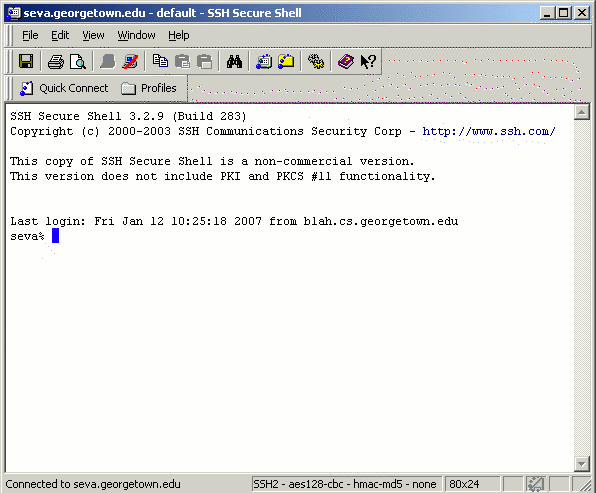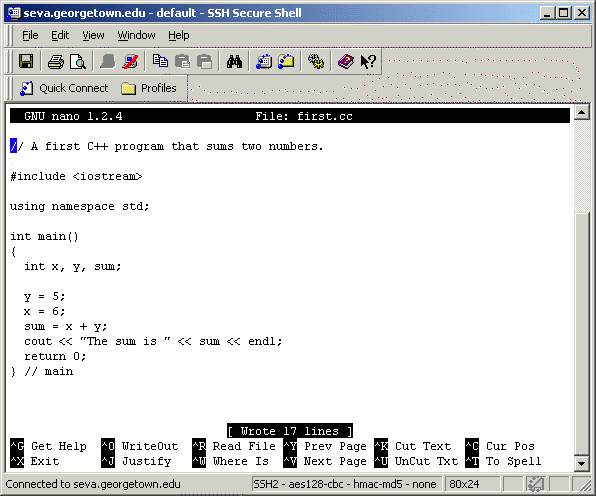
- Open an editor and create a program. To use the nano
editor type at the command prompt:
nano <program name>.
- As an example, type: nano first.cc
- This will create an empty file named first.cc.
- To get help in nano, type ^G by holding down the Control
key and pressing "G".
- Enter the following program:
// A first C++ program that sums two numbers. #include <iostream> using namespace std; int main() { int x, y, sum; y = 5; x = 6; sum = x + y; cout << "The sum is " << sum << endl; return 0; } // main - Once you have entered the program, type ^O to save your
file. The text in your window should look like the following:

- Exit nano by typing ^X, which will take you back to
the command prompt.
- One important command to know for nano is ^_ (Control-Underscore),
which takes you to a specific line in the file. If there is an error
in your program, the compiler often report the line on which the error
occurred. For large programs, it is a necessity to be able to go directly
to a line, rather than scrolling or paging to the line.
- NOTE: If you plan to do some more programming beyond this course, then I recommend that you learn and use the vi editor or the emacs editor. To get help for vi, at the UNIX prompt, type man vi, which will display the on-line manual page for vi. There is also an on-line vi Reference Card. There is also an online book entitled Learning the vi Editor, which available through the library's subscription to Safari Books Online. Similar resources exist for emacs. To use vi type: vi <program name> (e.g., vi first.cc). To use emacs type: emacs <program name> (e.g., emacs first.cc).
- At the UNIX prompt, type g++ first.cc
- If there are errors in your program, then they would be displayed,
and you'll need to edit the program to fix the errors.
- If you entered the program correctly, then you will be returned to
the UNIX prompt.
- The compiler creates an executable file called a.out, which
is the default name for executables. You can view the files in your
directory using the ls command.
- To run the program simply type a.out at the command prompt.
(If the system responds that the command was not found, then you need to
type "./a.out", without the quotes.)
- The program should produce the following output:
The sum is 11
- You can rename the executable by typing mv a.out first.exe,
which renames a.out to first.exe.
- You can also specify the desired name of the executable at compile time
by typing g++ -o first.exe first.cc. The -o option
specifies the name of the executable file.
- A transcript of this session follows. Boldface type indicates
things that the user typed. Comments appear after each command.
cs-class-1% <--- the command prompt (yours might look different) cs-class-1% ls <--- lists the directory, which is empty cs-class-1% nano first.cc <--- opens nano with the empty file first.cc cs-class-1% ls <--- lists the directory, which now contains the new file first.cc cs-class-1% g++ first.cc <--- compiles the program to a.out, the default name cs-class-1% ls <--- lists the directory, which now contains the compiled program a.out a.out* first.cc cs-class-1% ./a.out <--- executes the program a.out The sum is 11 cs-class-1% mv a.out first.exe <--- renames a.out to first.exe cs-class-1% ls <--- lists the directory first.cc first.exe* cs-class-1% ./first.exe <--- executes the program first.exe The sum is 11 cs-class-1% rm first.exe <--- removes first.exe cs-class-1% ls <--- lists the directory, which now contains only first.cc first.cc cs-class-1% g++ -o first.exe first.cc <--- compiles first.cc to first.exe cs-class-1% ls <--- lists the directory, which now contains first.exe first.cc first.exe* cs-class-1% ./first.exe <--- runs the program first.exe The sum is 11 cs-class-1% mv first.exe a.out <--- moves first.exe to a.out cs-class-1% ls <--- lists the directory a.out* first.cc cs-class-1% ./a.out <--- runs the program a.out The sum is 11 cs-class-1% logout <--- terminates the session